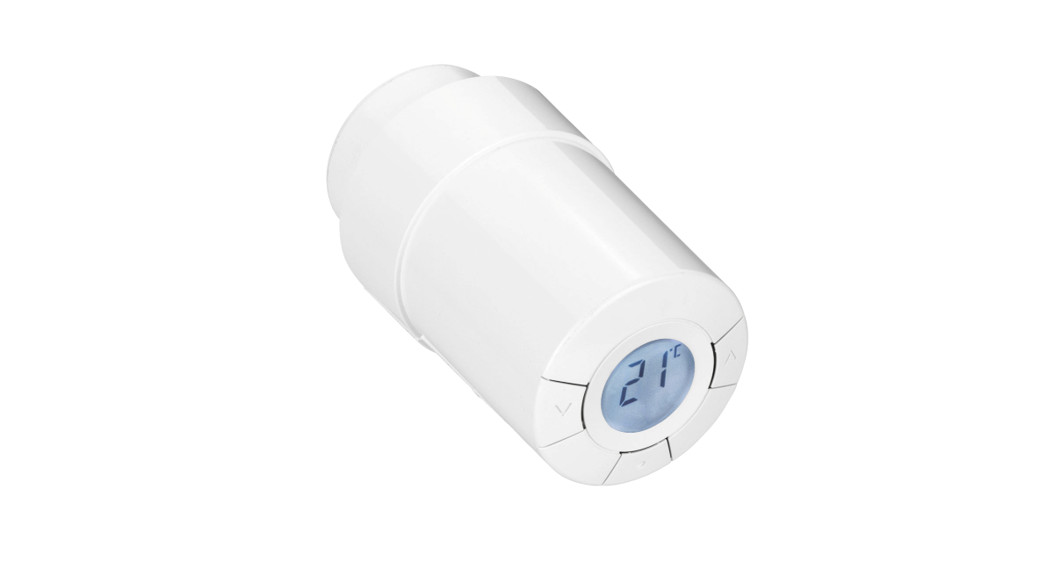
PoppRadiator Valve with TemperatureSensorSKU: POPE01010106-10-2020 16:59
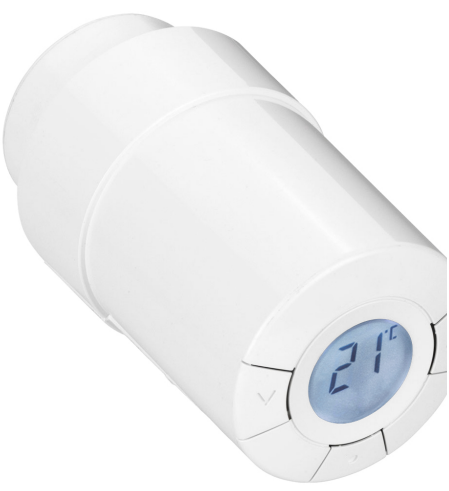
Quickstart
This is a Thermostat for Europe. To run this device please insert fresh 2 * AA batteries. Please make sure the internal battery is fully charged. Click on the function button “*” will confirm inclusion or exclusion and wake up the device for wireless communication. A long push for 3 seconds on the function button enters and leaves the management mode indicated by an “M” on the LCD display.
Important safety information
Please read this manual carefully. Failure to follow the recommendations in this manual may be dangerous or may violate the law. The manufacturer, importer, distributor, and seller shall not be liable for any loss or damage resulting from failure to comply with the instructions in this manual or any other material. Use this equipment only for its intended purpose. Follow the disposal instructions. Do not dispose of electronic equipment or batteries in a fire or near open heat sources.
What is Z-Wave?
Z-Wave is the international wireless protocol for communication in the Smart Home. This device is suited for use in the region mentioned in the Quickstart section.Z-Wave ensures reliable communication by reconfirming every message (two-way communication) and every mains powered node can act as a repeater for other nodes (meshed network) in case the receiver is not in direct wireless range of the transmitter.This device and every other certified Z-Wave device can be used together with any other certified Z-Wave device regardless of brand and origin as long as both are suited for the same frequency range.If a device supports secure communication it will communicate with other devices secure as long as this device provides the same or a higher level of security. Otherwise, it will automatically turn into a lower level of security to maintain backward compatibility.For more information about Z-Wave technology, devices, white papers, etc. please refer to www.z-wave.info.
Product Description
This device is a Z-Wave-controlled electronic radiator thermostat. It is mounted on wall heating valves and controls them by a motor. The device accepts a setpoint that is either set manually using buttons on the device or wirelessly using Z-Wave. Afterward, the device will regulate the warm water supply to the wall radiator and compare the detected temperature to ensure, that the temperature in the room is kept at the desired level. A small LCD panel on the device displays the setpoint temperature on request. Besides setting the desired temperature the device will support special heating schemes, such as energy-saving and frost protection, and intelligent functions like a valve training function to ensure that valves are still operational after longer periods. The Popp radiator thermostat can be mounted to valves with a standard M30x1.5 connector or RA2000. Opposite to the Danfoss TRV, this device will report the room temperature as detected and calculated by the device’s temperature sensor.
Prepare for Installation / Reset
Please read the user manual before installing the product.In order to include (add) a Z-Wave device to a network, it must be in the factory default state. Please make sure to reset the device into factory default. You can do this by performing an Exclusion operation as described below in the manual. Every Z-Wave controller is able to perform this operation however it is recommended to use the primary controller of the previous network to make sure the very device is excluded properly from this network.
Reset to factory default This device also allows being reset without any involvement of a Z-Wave controller. This procedure should only be used when the primary controller is inoperable.Remove the batteries and keep the function button “*” pressed for 5 seconds after the batteries are inserted back.
Safety Warning for BatteriesThe product contains batteries. Please remove the batteries when the device is not used. Do not mix batteries of different charging levels or different brands.
Installation
http://manual.zwave.eu/backend/make.php?lang=en&sku=POPE010101
| 1. Start by mounting the adapter. |  |
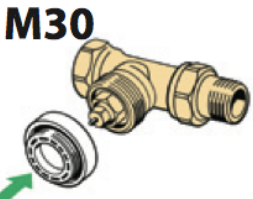 |
| 2. Tighten an RA adapter using the Allen key. Tighten an M30 adapter by hand (max. 5 Nm) | 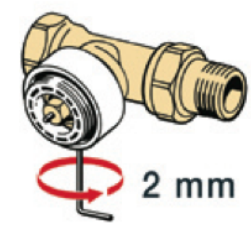 |
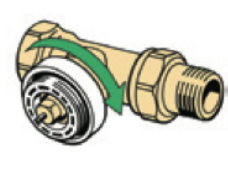 |
| 3. Screw the thermostat onto the adapter and hand-tighten (max. 5 Nm) | 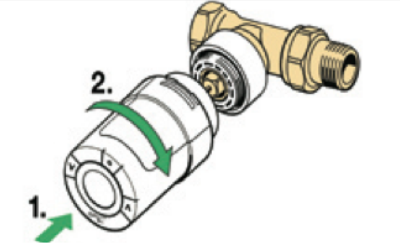 |
|
| 4. Press and hold |
||
| 5. Then turn the thermostat until It Is correctly oriented. |
Adjustment to the radiatorThe device can be adjusted to the room size. Three-room sizes are known. The factory setting is P2. Use P1 if the radiator appears oversized for the room. Use P3is undersized. To change the assumed room size press (p) for 3 seconds to enter management mode (M in the display). Press (v) until a “P” is displayed in the LCD display. Hit the (o) button. Now select 1, 2, or 3 using the arrow keys and exit with (o).RemovalTo remove the thermostat, insert an appropriate tool in the hole in the thermostat”s battery chamber (see illustration). Keeping the tool in position, turn the entire thermostat anticlockwise until it is completely unscrewed.Adjusting to the valveDuring the first night of operation, TRV will shut off the radiator heat and then open again to detect the exact opening point of the valve. This will allow TRV to heat as efficiently as possible. If necessary, the procedure is repeated once a night for up to a week. You might experience the valve being warm during the adjustment procedure, regardless of the room temperature.Intelligent Control (Forecast)During the first week of operation, TRV learns when it is necessary to start heating the room in order to reach the correct temperature at the correct time. The into control will continuously adjust the heating time compared to seasonal temperature changes.
Inclusion/Exclusion
On factory default, the device does not belong to any Z-Wave network. The device needs to be added to an existing wireless network to communicate with the devices of this network. This process is called Inclusion.Devices can also be removed from a network. This process is called Exclusion. Both processes are initiated by the primary controller of the Z-Wave network. The controller is turned into exclusion respective inclusion mode. Inclusion and Exclusion is then performed doing a special manual action right on the device.Inclusion
- Insert the batteries.
- Press the center button for 3 seconds until M appears in the display.
- Press the center button once again.
Exclusion
- Press the center button for 3 seconds until M appears in the display.
- Press the center button once again.
Product Usage
The TRV is operated by wireless commands from a Z-Wave controller.
- Direct setting of Temperature Set Point by Controller. (Attention: There may be a delay in the execution of a setpoint command due to the wakeup interval of the device. If the setpoint is to be changed at e.g. 16.00 and the wake-up interval is 15 minutes, make sure to send the command latest at 15.45)
The actual temperature setpoint is shown in the LCD display and can be overwritten by using the arrow keys on the device. This overwriting is temporary and only until the next change of the temperature setpoint (either triggered from external wireless command or from the internal downloaded schedule) becomes active.The actual measured ambient temperature is not shown on the LCD display but is reported to the central gateway.The device will also recognize an open window (sudden temperature drop within a short period of time) and turn down the heat for 30 minutes to save energy.Local LCD DisplayThe local LCD display gives information about the status of the device
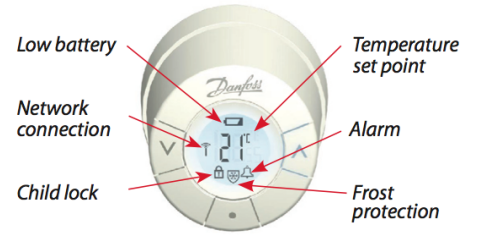
Link TestThe Thermostat allows checking the link quality to the controller device. Press the middle button (o) for 3 seconds until M is displayed. Select “LI” in the display using the arrow keys, then confirm the link test with the middle button. A blinking antenna symbol indicates the link test. If the antenna symbol keeps flashing after about 3 seconds there is a problem with the wireless connection. If the antenna symbol stops flashing, the link quality is sufficient. A successful link test will also terminate the exception mode described below.The device applies multiple technologies to extend battery life. It is combining multi commands to a single command and adapts its behavior to the capabilities of the network controller. Make sure to use Danfoss Living connects only with Z-Wave controllers fully implementing all battery lifetime extension methods recommended Danfoss. All controllers are based on Z-Wave. Me software (e.g. RaZberry) fully support these methods.When the battery level is low, the alarm bell icon flashes and the display will flash 8 times an hour between 19 and 22 hrs. If the battery goes flat, the system switches automatically to frost protection mode.
Node Information Frame
The Node Information Frame (NIF) is the business card of a Z-Wave device. It contains information about the device type and the technical capabilities. The inclusion-exclusion of the device is confirmed by sending out a Node Information Frame. Besides this, it may be needed for certain network operations to send out a Node Information Frame. To issue a NIF execute the following action: Clicking the function button
Communication to a Sleeping device (Wakeup)
This device is battery-operated and turned into a deep sleep state most of the time to save battery life. Communication with the device is limited. In order to communicate with the device, a static controller C is needed in the network. This controller will maintain a mailbox for the battery-operated devices and store commands that can not be received during a deep sleep state. Without such a controller, communication may become impossible, and/or the battery life is significantly decreased.This device will wake up regularly and announce the wakeup state by sending out a so-called Wakeup Notification. The controller can then empty the mailbox.Therefore, the device needs to be configured with the desired wakeup interval and the node ID of the controller. If the device was included by a static controller this controller will usually perform all necessary configurations. The wakeup interval is a tradeoff between maximal battery lifetime and the desired responses of the device. To wakeup the device please perform the following action: Clicking the function button “*”
Quick troubleshooting
Here are a few hints for network installation if things don’t work as expected.
- Make sure a device is in a factory reset state before including. In doubt exclude before include.
- If inclusion still fails, check if both devices use the same frequency.
- Remove all dead devices from associations. Otherwise, you will see severe delays.
- Never use sleeping battery devices without a central controller.
- Don’t poll FLIRS devices.
- Make sure to have enough mains powered devices to benefit from the meshing
Local Protection
The device can be turned into a child protection mode. In this mode all local operation is disabled. The protection mode is controlled wirelessly. However, there is a sequence to overwrite a protection state and to temporarily enable local operation: The protection can not be overwritten locally.
Technical Data
| Dimensions | 51x51x71 mm |
| Weight | 114 gr |
| Hardware Platform | ZM3102 |
| EAN | 0019962010101 |
| Battery Type | 2 * AA |
| Device Type | Thermostat |
| Generic Device Class | Thermostat |
| Specific Device Class | Setpoint Thermostat |
| Z-Wave Version | 4.55.00 |
| Certification ID | ZC08-15090002 |
| Z-Wave Product Id | 0x0002.0x0005.0x0175 |
| Frequency | Europe – 868,4 Mhz |
| Maximum transmission power | 5 mW |
Supported Command Classes
- Battery
- Climate Control Schedule
- Clock
- Manufacturer Specific
- Multi Command
- Sensor Multilevel
- No Operation
- Protection
- Thermostat Setpoint
- Version
- Wake Up
Controlled Command Classes
- Climate Control Schedule
- Clock
- Multi Command
- No Operation
Explanation of Z-Wave specific terms
- Controller — is a Z-Wave device with capabilities to manage the network. Controllers are typically Gateways, Remote Controls, or battery-operated wall controllers.
- Slave — is a Z-Wave device without capabilities to manage the network. Slaves can be sensors, actuators, and even remote controls.
- Primary Controller — is the central organizer of the network. It must be a controller. There can be only one primary controller in a Z-Wave network.
- Inclusion — is the process of adding new Z-Wave devices into a network.
- Exclusion — is the process of removing Z-Wave devices from the network.
- Association — is a control relationship between a controlling device and a controlled device.
- Wakeup Notification — is a special wireless message issued by a Z-Wave device to announces that is able to communicate.
- Node Information Frame — is a special wireless message issued by a Z-Wave device to announce its capabilities and functions.
(c) 2020 Z-Wave Europe GmbH, Antonstr. 3, 09337 Hohenstein-Ernstthal, Germany, All rights reserved, www.zwave.eu. The template is maintained by Z-Wave Europe GmbH. The product content is maintained by Z-Wave Europe GmbH, Support team, [email protected]. Last update of the product data: 2020-02-0414:34:26http://manual.zwave.eu/backend/make.php?lang=en&sku=POPE010101
References
manual.zwave.eu/backend/make.php?lang=en&sku=POPE010101
Z-Wave Europe – The leading european distributor for Smart Home products.
Z-Wave Europe – The leading european distributor for Smart Home products.
Z-Wave.Me
manuals-backend.z-wave.info/make.php?lang=en&sku=POPE010101
Z-Wave Europe – The leading european distributor for Smart Home products.
Z-Wave.Me
Z-Wave Europe – The leading european distributor for Smart Home products.
[xyz-ips snippet=”download-snippet”]

